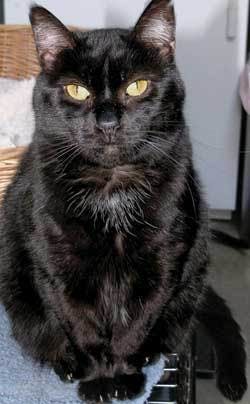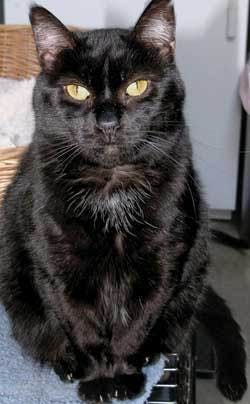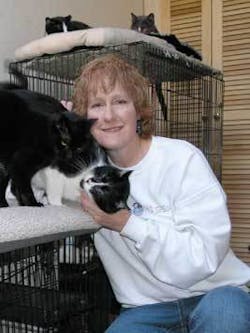cats & people
Cats are a lot like patients. You have to get to know each patient and each cat individually in order to develop a relationship that matters.
Like many hygienists I’ve known, I’m a cat lover. I once told my daughter that one of my life goals was to become a crazy old cat lady - you know, the kind you meet in the cat food aisle of the grocery store who tells you she knits booties for her cats. My daughter replied that I’ve already met this life goal, which is not quite true since I can’t knit. But I’ll admit that I’m crazy for cats and spend quite a bit of time with them.
In addition to spending time with my own two cats, I volunteer once a week at a local cat shelter. I usually spend two to three hours a week, feeding and playing with the cats, and cleaning up the huge mess that they make. I used to tell patients that when my hands weren’t in patients’ mouths, they were in the litter box. I stopped saying this after I got some looks from patients indicating they were not amused with the mental picture this evoked.
I have become an observer of cat behavior over the years, and have come to the conclusion that cats are a lot like patients. You have to get to know each patient and each cat individually in order to develop a relationship that matters. Although we try to find homes for as many of the shelter cats as possible, some of our cats are “lifers.” For various reasons, they are deemed “unadoptable.” These are the cats that, like long-time patients, I’ve gotten to know very well.
From a bad attitude to a grateful smile
“Scruffy” came to the cat shelter looking half dead, and acting meaner than a junkyard dog. She had long, matted fur, and her tail was always covered with feces, but she wouldn’t let anybody get close enough to groom her. If I got too close, she hissed and swatted, but stood her ground. She never moved from the countertop, at least not while I was in the room. She was emaciated and sniffed at food with interest, but ate very little. After several months of gentle talking to Scruffy, she finally allowed the shelter workers to touch her. Eventually some of the braver workers trimmed her dirty, matted fur. A vet extracted most of Scruffy’s teeth (she had severe periodontitis!), and she started eating and putting on some weight. After about a year, Scruffy was looking and acting like a new cat. While she never became a cuddly, purring, rub-up-against-your-ankles type of cat, she was friendly and seemed content. The shelter workers were all quite fond of Scruffy and had hopes that some day she might find a home. We were all devastated when she became ill and died within a very short period of time. Our only consolation was that we had made her last year of life the best year of her life.
Have you had any patients like Scruffy? They show up in your office with severe periodontitis and a bad attitude. They make it clear that they don’t like what you are doing to them, and they wish they were anywhere but in your chair. On top of all that, they have poor personal hygiene and you are also wishing they were anywhere but in your chair. Unfortunately, since they have perio, you know you will be spending a lot of time with them. You try to counteract their negativity by being extra kind and patient. By the time these patients come in for their fourth session of scaling and root planing, you notice that they are a little less hostile. At their three-month recare appointment, they actually greet you with a smile and leave with a thank you. Their hygiene has improved, and they seem like different people. You’re happy, knowing that you played a role in making them happier and healthier.
Love me and never stop
“Tristan” is the opposite of Scruffy. Tristan practically trips me every time I walk into the shelter. He throws himself down on my feet so I can’t move and looks up at me as if to say, “Pet me, love me, and never stop.” I bend down and give him lots of petting and then stand up to get to work. But every time I walk past Tristan, he puts out his paw to remind me that he’s there and wants more loving. Everyone loves Tristan; it’s impossible not to. Even the other cats love him.
Thank goodness we have a few Tristan-like patients. They’re the ones who come in with cookies and a big smile. They tell you that you’re the greatest hygienist in the world and they refer all their friends to your office. They always have a positive attitude and brighten up even your worst days.
Baby steps with Sir Hiss
And then there’s “Sir Hiss.” Sir Hiss came to the shelter as a feral kitten. He was the tiniest bit of white fluff with gorgeous blue eyes. But like most feral cats, he was terrified of humans. He cowered with his one littermate in a cage (he was too young and scared to roam the shelter freely). Every time I opened the cage door to feed him, he moved as far away from me as possible, put his ears back, and hissed. I couldn’t help but laugh at this tiny, beautiful kitten trying to appear so ferocious. I decided to make friends with him. I began by talking very gently to him and did this for months. When he was old enough to leave his cage, I would walk up as close as I could, kneel down and look him in the eye, and talk quietly to him. If I accidentally got too close, he would hiss and run. This went on for many months. I never tried to touch him. One day I came in to the shelter and Sir Hiss came very close to me. I thought he must not have noticed that I was standing there and continued cleaning. Several times Sir Hiss came within petting distance. Finally, I reached out and touched him as he was walking away. He turned and looked at me in amazement, hissed, and ran. But then he came back. Again I petted him, again he hissed, and ran. And came back. Over a period of about two years, this frightened little white fur ball transformed into a lovable cat that now climbs in my lap to be petted. He’s still scared of everybody else who comes in, but he trusts me.
We’ve all met patients who, like Sir Hiss, are absolutely terrified to come to the dentist’s office. With a lot of patience and gentleness, and by taking baby steps and proceeding slowly, we can win over these patients. I once had a patient who had never had any dentistry done without general anesthesia. She was in her mid-20s and had recently married. Her husband told her it was time she had her dentistry done without general anesthesia, and I happened to be the hygienist who had her on my schedule. I have never seen anyone so scared to be in the dental chair as this woman.
I spent a lot of time at that first appointment just talking to her. She was terrified of everything, even the mouth mirror. I cleaned one tooth that day. Although it was many years ago, I remember that it was Tooth No. 6, and I cleaned it with a curette in my right hand and the patient holding tightly to my left hand. She came back two more times, and each time she was slightly more relaxed. Unfortunately, she moved after that and I never finished her cleaning. But I’ve never had a more grateful, appreciative patient than that terrified woman.
Pandora’s box: Who is missing from it?
“Pandora” is the old matriarch of the shelter. Pandora has black fur that is beginning to gray. She lived on the streets for many years before coming to the shelter. Life was not easy for Pandora back then. She had scars, a notched ear, was malnourished, suffered from seizures, and probably had several litters before she came to us. She was middle-aged and pregnant when she arrived. She was terrified of humans.
With time, patience, and a lot of love, Pandora has become a favorite in the shelter. She doesn’t like the other cats very much, but grooms every kitten that comes close to her. She is old and deaf, but content. She has shelter, food, a warm bed, medical care, and lots of love. What more can a cat ask for?
Pandora was lucky. Life in the shelter is good for her. But she reminds me of all the people who are not so lucky. There are a lot of people who are not patients of ours because they can’t afford to come see us. Some of them are homeless.
There are very few options for these people when they need dental care. It’s not that dental hygienists are uncaring; they are generally some of the most caring people in the world. I suspect many would be willing to help these people, but most of us cannot practice without a dentist’s supervision. And so the human “Pandoras” will continue to suffer.
Each cat at the shelter has his/her own personality. Many were strays and came with “baggage.” Some are easy to love, some refuse to come near me. Some are scared, some are relaxed. Some are trusting, some are suspicious. They all fascinate me and I wish they all could get a loving home.
Likewise, every patient who comes into our offices has his/her own personality. Many come with “baggage.” Some are easy to like, some are difficult to like. Some are scared, some are relaxed. Some are trusting, some are suspicious. They all fascinate me and I try to treat each patient with the respect that he/she deserves.



